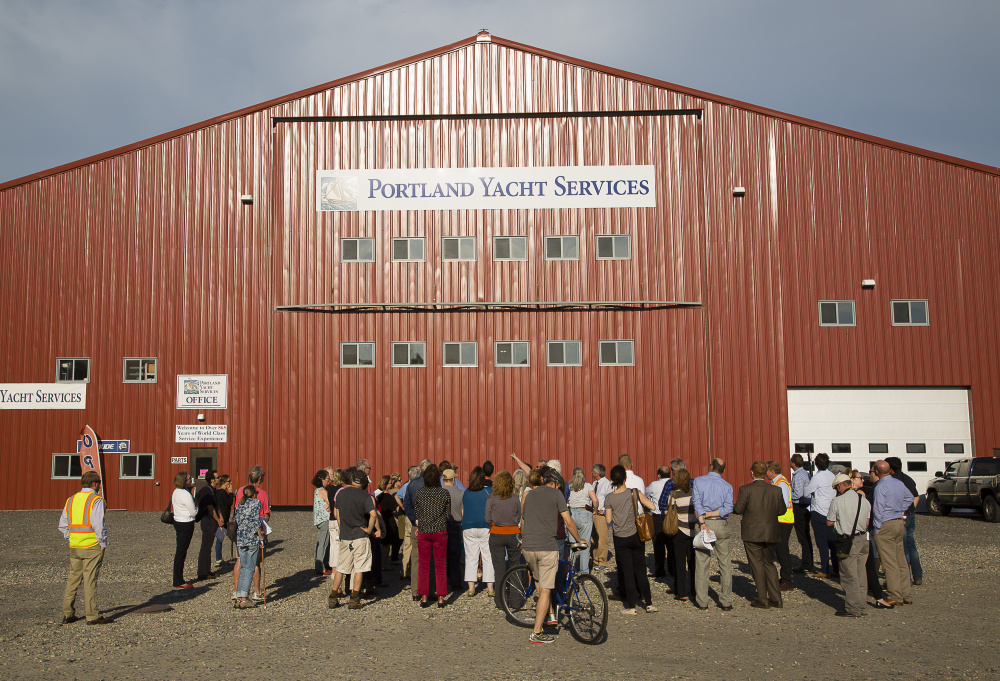The City Council approved a zoning change Wednesday night that would allow the construction of a refrigerated warehouse on Portland’s western waterfront that supporters say is critical to economic development in the state, particularly in the food and beverage industry.
The change will raise the height of buildings in the waterfront port development zone from 45 feet to 55 feet, and 75 feet for specific, port-related uses, including a planned cold-storage building adjacent to the International Marine Terminal.
It also has restrictions that limit the footprint of buildings and mitigates visual obstruction tall buildings would create.
The council voted 8-1 in favor of the zoning change, with Councilor Spencer Thibodeau voting against the measure. Thibodeau represents District 2, which includes residents of the West End who advocated strongly against raising the height limit to 75 feet.
“Tonight, I still think it is the right opportunity for Portland, but it is not the right height,” Thibodeau said.
The development zone in question stretches from west of the Casco Bay Bridge to Veteran’s Memorial Bridge and includes Portland Yacht Services, the International Marine Terminal and Sprague Energy. There are only a handful of landowners in the 45-acre strip of land, which has been set aside primarily for marine-related industries.
In 2015, the Maine Port Authority selected Americold, a huge cold-storage company, to construct and operate a freezer warehouse on the Portland waterfront.

This rendering shows the planned cold-storage facility west of the Casco Bay Bridge.
Officials from the Maine Port Authority and the business community have said cold storage is critical to economic development and the state’s food and beverage industry. It also will help cement the relationship between Portland and Eimskip, the Icelandic shipping company headquartered in Portland.
That decision triggered a proposal to change height rules in the zone to allow a 68-foot tall building Americold said it needed to make the project economically viable.
Initial proposals, however, raised concerns among some West End residents that changes would allow huge buildings that would block views of the Fore River and create a wall of along Commercial Street, a gateway into the city.
The zoning changes that were eventually developed went further, creating a framework that will allow the city to pursue waterfront development opportunities in the future, Planning Board Chairwoman Elizabeth Boepple told councilors. The planning board voted unanimously to recommend approval of the zoning change.
The changes were debated for almost a year and included 40 public meetings and multiple public hearings as well as multiple studies regarding the economic viability of the project.
To alleviate neighborhood concerns, the planning board approved zoning changes that allowed higher buildings, but required sight corridors between buildings, a set-back from Commercial Street and limited the size of building footprints.
“I’ve concluded the proposal before us is the wisest decision,” District 5 Councilor David Brenerman said.
“The biggest question for me, is are we going to have a 21st-century port or not.”
About two dozen residents and business owners lined up to speak on the zone changes. Many waterfront business owners and representatives of economic development agencies said the changes were critical to provide jobs and economic growth in Portland and the region. The cold storage facility would support the state’s growing food and beverage industry, and shore up the city’s relationship with Eimskip.
Phineas Sprague, owner of Portland Yacht Services, teared up as he declared that the zoning change would help him fulfill the dream of a world-class port he had when he moved to Portland 40 years ago.
“Tonight you have the opportunity to do something that is important for the city of Portland for generations to come,” Sprague said. The zoning change would allow his company to build a bigger building than currently permitted, allowing it to work on large boats like public ferries on Casco Bay.
But some residents of the West End urged the council to vote against allowing a building up to 75 feet tall. An “industrial behemoth” would scar the waterfront for generations, several warned.
Many opponents said they supported waterfront development and a cold storage building, but argued Americold had not presented any evidence to prove it needed a building that high to be economically viable – a 55-foot high building would work just as well, they argued.
“Despite two promises to demonstrate finance need for the project, it has not been demonstrated by Americold itself,” said Anne Pringle, president of the Western Promenade Neighborhood Association.
Peter McGuire can be reached at 791-6325 or at:
pmcguire@pressherald.com
Twitter: @PeteL_McGuire
Send questions/comments to the editors.




Comments are no longer available on this story